Sculpture
deCordova Sculpture Park and Museum
Lincoln, MA
May 15, 2010 – August 29, 2010
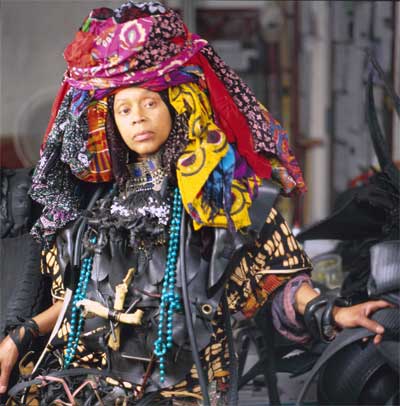
Photo of Chakaia Booker by Nelson Tejada.
I had not been to the deCordova for a long time and, looking for a quiet, but interesting, afternoon, ventured out to meander through the park and see what was up in the museum. This exhibit was the main one inside and I was totally taken by it. I had never heard of Booker before this. She is an African-American sculptor, now in her late fifties; she has great ingenuity and talent and gives new meaning to the phrase black is beautiful.
She uses, almost exclusively, black tires, of all sizes and textures, as the external medium for her work. Who would have thought that cutting, tearing, twisting and putting together pieces of tire could yield works that were so interesting. It really is something to see what she is capable of doing.
Holla (2008) is a kind of gryphon-like figure with a scaled head and loopy-type feathers. It was the first piece I saw, and I thought what a great use of the medium.
The Fatality of Hope (2007) is a mural with almost Jackson Pollock-like qualities – filled with gestural energy and a real rhythm of textures. (Jackson Pollock, for those who have not heard of him, was one of the great American abstract expressionist painters of the 1950s and 1960s, who became famous for his splatter and drip paintings.)
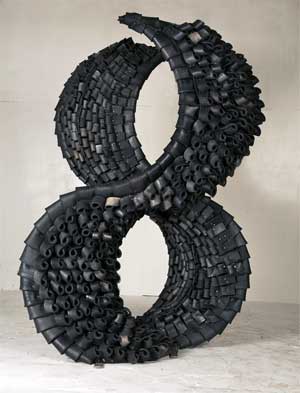
Anonymity (2007) by Chakaia Booker
Courtesy of the artist, Marlborough Gallery, NY and deCordova Sculpture Park and Museum
Anonymity (2007) depicts what seems like two arching, dancing cobras. So different from Holla! And both – all out of tires!
Sugar In My Bowl (2003) has a flaked exterior, reminiscent of Edward Koren’s cartoon creatures (check out The New Yorker to see his stuff), with looped insides that give the feeling of amazing pieces of tripe. Memories of menudo (Mexican tripe and hominy soup).
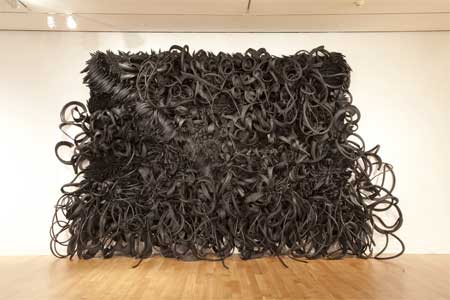
It’s So Hard To Be Green (2000) by Chakaia Booker
Courtesy of the artist, Marlborough Gallery, NY and deCordova Sculpture Park and Museum
It’s So Hard To Be Green (2000) is another Pollock-esque piece, with pieces of inner tube forming a part of it (the previous pieces just had outer, treaded, tires). It also has the feel of a later Frank Stella (the very austere modernist painter from the 1960s and 1970s who totally changed his style in the 1980s, becoming wild, multi-dimensional, sculptural and colorful in a very exciting and liberating way).
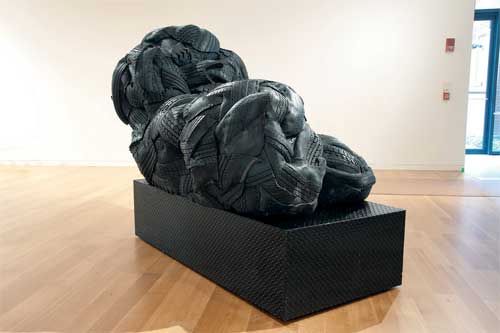
Untitled (Male Torso That Left His Path) (1992-1995) by Chakaia Booker
Courtesy of the artist, Marlborough Gallery, NY and deCordova Sculpture Park and Museum
Untitled (Male Torso That Left His Path) (1992-1995): I’m not sure why Booker goes to the trouble to give this piece the title Untitled when she has such an elaborate and descriptive subtitle, but who am I to quibble? This is an amazingly compact and knotted construction with, yes, discernible buttocks and a corroded, but discernible, penis. For those who love metaphors and the interpretation of signs, this piece has wonderful semiotic (the philosophical study of signs) associations: the leaving his path part of the title is just so great to think about in a sculpture made entirely of tire treads!
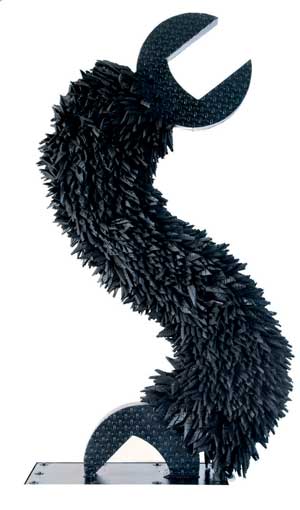
(Wrench) (Wench) II (2001) by Chakaia Booker
Courtesy of the artist, Marlborough Gallery, NY and deCordova Sculpture Park and Museum
(Wrench) (Wench) II(2001) is a witty and hairy version of an open-end wrench depicted as a kind of yearning animal with a wrench-space for a mouth. It calls to mind some of Pablo Picasso’s ingenious animal sculptures, and also the work of the pop sculptor, Claes Oldenburg.
From the wall of that explanatory exhibition: One of the reasons Chakaia Booker works in tires is because of the relationship she sees between various tire treads and African textiles and scarification. There are nice photos of African people and textiles to demonstrate the point.
Small, supplementary exhibit, but good curating!
– BADMan
Leave a Reply